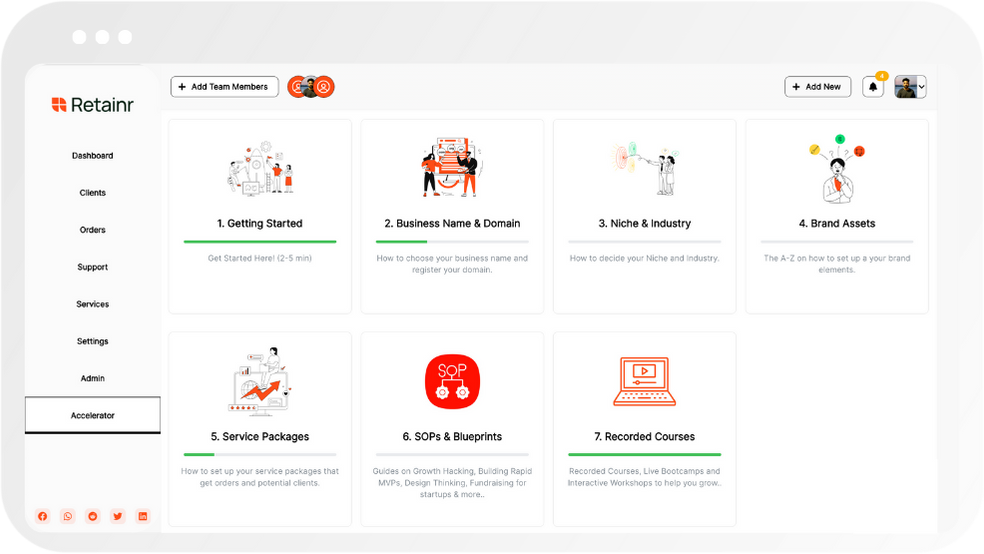
5 Investment Risks and How to Manage Them
Build with Retainr
Sell your products and services, manage clients, orders, payments, automate your client onboarding and management with your own branded web application.
Get Started1. What are the top five investment risks and how can they be managed?
Top Five Investment Risks
Investment is a broad field that includes myriad risks. However, some of these risks are more prevalent and can have a more significant impact on the returns if not well managed. They are:
- Market Risk: This is also known as systematic risk and can't be eliminated through diversification. It is influenced by several unpredictable factors like inflation, political unrest, and changes in interest rates.
- Credit Risk: The risk that a debtor will fail to meet their obligations to pay back their debt.
- Liquidity Risk: The risk that occurs when an investor cannot buy or sell investments quickly without causing a significant change in its price.
- Operational Risk: These arise from failures in procedures, systems, and policies.
- Inflation Risk: The hardship of the loss of purchasing power due to the rise in prices of goods and services, which can erode investment returns over time.
Managing Investment Risks
Even though investment risks cannot be completely eliminated, they can be well managed. By understanding these risks, making sound decisions, and taking active steps, investors can mitigate potential losses and increase their earning potentials.
| Risk | Management Strategy |
|---|---|
| Market Risk | Thorough market analysis and trend projection |
| Credit Risk | Assessing the creditworthiness of a debtor |
| Liquidity Risk | Investing a portion of assets in liquid form |
| Operational Risk | Effective internal checks, controls, and balance system |
| Inflation Risk | Investing in assets that should outpace inflation in the long term |
Risk management pertains to the identification, assessment, and mitigation of potential risks that could negatively influence investment returns. By understanding the type of risks that can occur, investors can equip themselves with the necessary knowledge and strategies to make informed investment decisions.
2. How can market risk be handled effectively in an investment portfolio?
Understanding Market Risk
Market risk, also known as systematic risk, refers to the likelihood of an investor experiencing losses due to factors that affect the entirety of the financial markets. When dealing with market risk, investment trends can be largely unpredictable, influenced by political, economic, and social factors that change over time. Some notable examples of factors precipitating market risk include interest rate changes, inflation, recession, wars, and natural disasters.
Ways to Effectively Manage Market Risk
To effectively handle market risk in an investment portfolio, several actions can be taken:
- Diversification: This strategy involves allocating investments across various financial instruments, industries, and other categories to mitigate potential losses.
- Asset Allocation: Distributing investments across different asset classes (such as bonds, stocks, and cash) can help smooth out market volatility.
- Hedging: This involves setting up investment positions intended to offset potential losses that may be incurred by other investments.
- Use of Index funds: Index funds usually provide a broad market exposure, low operating expenses and low portfolio turnover.
- Regular Rebalancing: This involves adjusting the proportions of assets in a portfolio to maintain desired level of risk and return characteristics.
Market Risk Strategies Assessment Table
| Strategy | Pros | Cons |
|---|---|---|
| Diversification | Helps spread risk across various investments | Does not guarantee against loss |
| Asset Allocation | Offers potential for higher returns and risk control | Requires careful monitoring and rebalancing |
| Hedging | Can offset potential losses | Can carry significant costs and limit potential gains |
| Use of Index funds | Provides broad market exposure and minimizes costs | Limited to overall performance of the market |
| Regular Rebalancing | Maintains desired level of risk and return | May result in short term capital gains taxes |
3. What steps can be taken to minimize the impact of inflation risk on investments?
Understanding Inflation impact
Inflation risk refers to the deteriorating value of assets or income due to the rising cost of living. In terms of investment, inflation could minimize the actual returns, creating considerable losses for investors if the rate of return on an investment is less than the rate of inflation. Some common steps can be taken into account to mitigate this risk.
Ensure your investments outpace inflation
- Invest in Stocks: Over the long term, stocks have consistently provided a higher rate of return than inflation.
- Invest in Real Estate: Real estate has the potential to offer returns that beat inflation. The rental income can also increase over time, helping maintain the investor’s purchasing power.
- Invest in Inflation-Protected Securities (IPS): These are government-issued bonds that increase with inflation. They provide a fixed interest rate, but the principal adjusts with inflation.
Inflexion Risk and Asset Allocation
| Asset Type | How It Helps Diversify Against Inflation Risk |
|---|---|
| Stocks | Companies can potentially increase prices to keep up with inflation, which could lead to higher earnings. |
| Real Estate | Property values and rents usually increase during times of inflation. |
| Commodities | Commodities such as gold, oil, and agricultural products typically perform well during inflation, as their prices rise. |
| TIPS (Treasury Inflation-Protected Securities) | This bond's principal increases with inflation, providing an investor a level of protection. |
The balanced combination of asset types in your portfolio plays a significant role in hedging against inflation risk. Establishing a varied portfolio limits exposure to any one type of asset and can help keep pace with inflation.
4. How can investors protect themselves from liquidity risk?
Understanding Liquidity Risk
Liquidity risk refers to the possibility of not being able to buy or sell investments quickly enough to prevent or minimize a loss. This is a common risk in thinly traded or less liquid markets where there are not enough buyers or sellers. Investors could potentially face large losses if they have to sell in these conditions or in a volatile market where prices can change quickly. Therefore, understanding how to manage liquidity risk is key in investment.
Strategies to Manage Liquidity Risk
There are several strategies that investors can use to manage liquidity risk:
- Diversification: By spreading investments across different types of assets, investors can reduce the potential for liquidity risk. If one asset becomes illiquid, other assets may still be easily traded.
- Investing in liquid assets: Liquid assets, like stocks, can generally be sold quickly without having a significant impact on the price.
- Holding cash reserves: Keeping a portion of an investment portfolio in cash can help meet any immediate cash needs without having to sell potentially illiquid assets.
- Understanding market conditions: By keeping an eye on market news and understanding any factors that may affect the liquidity of a particular investment, investors can better anticipate and manage liquidity risk.
Liquidity Risk and Investment Types
The level of liquidity risk can vary significantly depending on the type of investment. As noted above, investing in liquid assets can reduce this risk. Below is a table illustrating the relative liquidity of different types of investments:
| Investment Type | Relative Liquidity |
|---|---|
| Stocks | High |
| Bonds | Medium to High |
| Real Estate | Low |
| Private Equity | Very Low |
5. How does interest rate risk impact investments and what measures can be taken to mitigate this risk?
Impact of Interest Rate Risk on Investments
Interest rate risk is one of the many potential risks that affect investments. This risk arises from the potential changes in the interest rates that can significantly impact the value of investments. For instance, when interest rates increase, the value of existing fixed-income investments like bonds decreases. Similarly, a rise in interest rates can make borrowing for companies expensive, which can lead to reduced profits, eventually resulting in a decrease in the price of the company's stocks.
| Type of Investment | Effect of Increased Interest Rate |
|---|---|
| Bonds | Decrease in market value |
| Stocks | Potential decrease in stock's price due to reduced profits |
| Real Estate | Drop in property value due to decreased demand( as borrowing gets expensive) |
How to Mitigate Interest Rate Risk
While it is impossible to eliminate interest rate risk altogether, it is possible to manage and mitigate its impacts. Here are some of the strategies:
- Laddering: Investors can diversify the maturity dates of their bond investments. This strategy, known as laddering, reduces the risk associated with all bonds maturing at a time when interest rates are high.
- Diversification: Diversifying investment between different asset categories which respond differently to interest rate changes can also help. In other words, allocating a fraction of one’s portfolio to stocks, bonds and other asset classes can provide a hedge against interest rate risk.
- Hedge with Interest Rate Derivatives: Investors can also use financial instruments like interest rate futures, options and swaps as they can provide a hedge against the risk.
6. What strategies can be used to manage the diversification risk in an investment portfolio?
Understand the Importance of Diversification
Diversification is a powerful tool for managing investment risks. It involves spreading your investments across different asset classes to reduce the impact of negative performance in any one area. By investing in a mix of asset types - stocks, bonds, commodities, real estate etc. - you, mitigate the risk theorized as 'not putting all your eggs in one basket.'
- Assess your risk tolerance: Understanding your capacity to endure losses will help define how broad a range of investments is right for you.
- Consider your investment timeframe: The longer you intend to keep your money invested, you may be able to handle a greater portion of higher-risk investments.
- Regularly review and reallocate: As market conditions change, the diversity of your portfolio may shift due to varied performance of individual investments - revaluate periodically to maintain balance.
Invest in Different Geographic Markets
Similar to diversifying across asset classes, diversifying geographically can further mitigate economic risks. Different regions often experience unique economic cycles - downturns in one geographic area can be offset by stronger performance elsewhere. This principle can apply at various levels, from domestic vs. international markets to distinction between emerging and developed economies.
| Investment | Geography |
|---|---|
| Stocks | United States, Europe, Asia |
| Bonds | United States, Eurozone, United Kingdom |
| Real Estate | Domestic, International |
Utilize Mutual Funds and ETFs
Assets like mutual funds and Exchange Traded Funds (ETFs) offer automatic diversification, as they are composed of many different investments. Instead of attempting to select individual stocks and bonds, these instruments take the hardship out of building a diverse portfolio.
- Mutual funds: Managed by professionals, these investment vehicles pool money together from many investors to buy a diversified range of investments.
- ETFs: These are similar to mutual funds, but are traded on stock exchanges like individual stocks. ETFs often gravitate towards tracking specific indices or sectors, allowing investors to diversify within specialized areas of the market.
7. What is the best approach to deal with political or regulatory risks impacting investments?
Understanding Political and Regulatory Risks
Political or regulatory risks refer to the potential for investments to suffer losses due to changes in a country's political environment or policies. These can include civil unrest, change in government, policy alterations and regulatory changes that may impact the functioning of a company. Unpredictability and uncertainty in politics can pose a challenge for companies operating in a country, thus influencing the investor sentiment.
- Civil Unrest: Sociopolitical tensions and civil unrest can significantly impact the value of an investment.
- Change in Government: Elections and change in government can bring new policies that may impact business operations and profitability.
- Policy and Regulatory Changes: Changes in regulations, changes in tax codes, stricter environment laws, or changes in trade policies can all affect the profitability of a company.
Strategies to Manage Political and Regulatory Risks
Several strategies can be employed to manage political and regulatory risks. These strategies generally involve diversification and staying informed about political developments and policy changes in countries where your investments are located. It’s always prudent to have a global perspective on your investments.
- Diversification: Spreading investments across various countries can help reduce potential risk.
- Staying Informed: Regular monitoring of political environments and pending regulatory changes can give investors a competitive edge.
- Incorporating Political Risk in Decision Making: When evaluating the profitability of a potential investment, consider the political stability of the country and the likelihood of regulatory changes.
Adjusting for Political and Regulatory risks
| Adjustment Strategy | Description |
|---|---|
| Diversification | Investing in a diverse portfolio can spread the risk and improve potential returns. |
| Proactive Investment Analysis | Regular market analysis and keeping tabs on political news help to foresee potential investment threats. This enables proactive decision making. |
| Political Risk Insurance | Certain types of insurance are available which provide coverage for some political risks. Insurers can compensate for the losses based on the agreed terms in the insurance contract. |
Political and regulatory risks can't be completely eliminated. However, by implementing these strategies, investors can manage these risks efficiently and steer their investment portfolio towards growth.
8. Can you provide real-life examples of how to manage these five investment risks?
Market Risk Management
In dealing with market risk, diversification is the key. For instance, if you've invested in technology stocks, which are volatile, you should offset it with investments in other sectors that are stable, such as utilities. Don't concentrate your investment portfolio in a single asset class, spread it across stocks, bonds, commodities, real estate, etc.
Liquidity Risk Management
A real-life example of managing liquidity risk is maintaining an emergency fund. It's advisable to have at least 3 to 6 months of living expenses saved in an easily accessible account. Additionally, investing in assets that can be easily sold without a significant change in their value, like government bonds or blue-chip stocks, can also manage liquidity risk.
Credit Risk Management
One way of managing credit risk is by investing in companies with low debt and stable income. As an example, instead of investing in a new start-up with a high debt-to-equity ratio, you could invest in a well-established company with a good credit rating and a low debt-to-equity ratio. Doing your due diligence thoroughly before investing can mitigate credit risk.
Managing Inflation Risk and Interest Rate Risk
Inflation risk can be managed by investing in assets that have the potential for higher returns. For instance, real estate often appreciates over time, which can offset the effects of inflation. Similarly, to manage interest rate risk, a laddering strategy can be used. Here is a tabular representation of a 5-Year CD ladder:
| Year 1 | Year 2 | Year 3 | Year 4 | Year 5 |
|---|---|---|---|---|
| Invest in 5-year CD | Invest in 5-year CD | Invest in 5-year CD | Invest in 5-year CD | Reinvest maturing CD for 5-year term |
In this strategy, you divide your investment across different term lengths. When the shortest term CD matures, you reinvest that money into a new 5-year CD. By doing this, not all your money is tied up for a long period, and you're also able to take advantage of possible higher interest rates in the future.
9. How can the use of modern technology, like investment apps or platforms, aid in managing these common investment risks?
Utilizing Investment Apps and Platforms
Modern technology has revolutionized the finance industry, particularly the investment sector. Investment apps and online platforms have simplified the once complex and arduous process of managing investments. These tools are not only convenient to use, but they also offer several features that can help manage common investment risks.
- Automated Risk Assessment: Some apps and platforms provide an automated assessment of your risk portfolio. This helps investors understand their risk tolerance level and accordingly choose suitable investments.
- Data Analytics: Most of these platforms come equipped with powerful data analytics features. These analytics can help you identify trends, track your investment performance, and even anticipate market shifts.
- Diversification Tools: Modern technology platforms often provide tools that help diversify investments. Diversification is a known strategy for managing investment risks and these tools make it much easier.
- Real-Time Updates: Investment apps provide real-time updates on market movements and fluctuations. Staying informed can have a massive influence on investment decisions and managing risks.
- Educational Resources: Numerous platforms provide educational content, such as webinars, articles, and tutorials, to increase investor knowledge and comfort with investment strategies and risks.
Applying Technology to Manage Investment Risks
To highlight the effectiveness of technology in managing investment risks, consider the table below that shows a comparison between traditional methods and the utilization of modern technology:
| Traditional Methods | Modern Technology | |
|---|---|---|
| Risk Assessment | Manually evaluating risks | Automated risk assessment |
| Investment Tracking | Periodic check-ups | Real-time updates and analytics |
| Diversification | Manually spreading investments | Diversification tools available |
| Education | Self-learning from various sources | Access to organized educational content |
In conclusion, the use of modern technology such as investment apps and platforms can significantly aid in managing common investment risks by providing automated solutions, real-time updates, and valuable educational resources.
10. Is it possible to entirely eliminate these investment risks and what are the potential repercussions if these risks are not properly managed?
Elimination of Investment Risks
No, it's practically impossible to entirely eliminate these investment risks. Each type of investment comes with their unique risks and these risks are an inherent component of investing. However, methods for managing these risks can certainly minimize potential losses. In managing these risks, strategies such as diversification, careful asset allocation, undertaking thorough research, regular monitoring of investments and rebalancing of portfolio can be employed. Practicing these risk management methods consistently significantly reduces the likelihood of severe damages to your investment.
The Effects of Poor Risk Management
On the other hand, the repercussions could be severe if these risks are not properly managed. An improperly managed risk can lead to significant financial losses and impact an investor's overall financial health. The below mentioned list indicated some potential repercussions of poor risk management:
- Capital loss: The actual amount of capital invested can drastically decrease if investments do not perform well.
- Credit risk: If the party you’ve invested in defaults on their financial obligations, you may lose your entire investment.
- Liquidity risk: In case of emergency, you might not be able to readily convert your investments into cash.
- Inflation risk: The returns on your investments might not keep pace with the rising cost of living.
Comparison Between Properly and Improperly Managed Risks
The following table provides a comparison between properly managed and unmanaged risks:
| Properly Managed Risks | Improperly Managed Risks | |
|---|---|---|
| Portfolio Value | Maintains stability and growth | Decreases and can cause severe losses |
| Liquidity | Investments can be readily converted into cash | Investments may not be readily available for converting into cash |
| Investment Return | Potentially outpaces inflation | May not keep pace with inflation causing loss of buying power |
Conclusion
Understanding 5 Investment Risks and Their Management
Investing can provide you with potential financial growth, but it also comes with varying degrees of risks. This blog highlights five common investment risks: market risk, credit risk, liquidity risk, inflation risk, and geopolitical risk.
Market risk occurs due to economic factors that influence the entire market. Credit risk is associated with the possibility of a debtor defaulting. Liquidity risk is about the difficulty in quickly turning an investment into cash without significant loss. Inflation risk is connected to the potential decrease in the purchasing power of money. Lastly, geopolitical risk arises from political or geo-economic instability.
Strategies to manage these risks include diversifying your investment portfolio, assessing your risk tolerance, staying attentive to market trends and fundamentals, considering the long-term prospects of your investments, and getting the help of financial advisors.
Manage Your Business with Retainr.io
Managing your business and investments can be overwhelming. This is where Retainr.io comes in. It's a whitelabel software solution designed to help you sell, manage clients, orders and payments through your own branded app.
Retainr.io serves not just as a business tool, but also as an extra hand to ensure your operations run smoothly. From tracking orders to managing payments and clients, this software streamlines every aspect of your business, so that you can focus on making sound investment decisions and growing your business.
To experience the difference Retainr.io can make, visit our website and explore the features of our software.
Boost Your Agency Growth
with Retainr Accelerator
Uncover secrets, strategies, and exclusive blueprints to take your agency's growth to the next level — from marketing insights to effective presentations and leveraging technology.

SOPs, Cheatsheets & Blueprints
Leverage 50+ SOPs (valued over $10K) offering practical guides, scripts, tools, hacks, templates, and cheat sheets to fast-track your startup's growth.
Connect with fellow entrepreneurs, share experiences, and get expert insights within our exclusive Facebook community.
.jpg)

Join a thriving community of growth hackers. Network, collaborate, and learn from like-minded entrepreneurs on a lifelong journey to success.

Gain expertise with recorded Courses, Live Bootcamps and interactive Workshops on topics like growth hacking, copywriting, no-code funnel building, performance marketing and more, taught by seasoned coaches & industry experts.

.jpg)

.jpeg)


